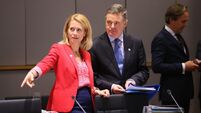David McNamara: The three key drivers of inflation have now largely dissipated

The sharp rise in wages across the Eurozone in recent years, which has underpinned services inflation, appears to be moderating. File picture: Dan Linehan
The latest Eurozone macroeconomic data suggest price pressures continue to moderate in line with expectations, building the case for a cut in ECB interest rates at its next meeting in June.
Last week’s Eurozone inflation release showed a 2.4% rise in consumer prices in April, just above the ECB’s 2% target.
The release also details the sectoral contributions to inflation and shows broad-based disinflation continuing across most areas, including a welcome fall in services inflation to 3.7% from the 4% rate which had prevailed for several months prior.
Energy prices continue to contract, down 0.6% in the year to April, but the deflationary impact here is waning.
Nevertheless, while some bumps in the road to a sustainable 2% inflation rate can be expected, the broader drivers of the inflationary surge in recent years have now largely dissipated.
Firstly, the Eurozone has managed to diversify its energy mix and suppliers, particularly in relation to natural gas, and while exposed to price shocks as a net importer of energy, the region has much more resilience than before the Russian invasion of Ukraine.
Secondly, the supply chain pressures evident post the pandemic in 2021/22, which drove up wholesale and consumer prices have also dissipated, as consumer demand normalised and firms built in resilience to geopolitical and trade disruption. This is evidenced by the relatively muted impact of the Red Sea trade disruption so far in 2024.
Thirdly, the sharp rise in wages across the Eurozone in recent years, which has underpinned services inflation, appears to be moderating sharply. With official Eurozone wage data released at a significant lag, surveys such as the Indeed Wage Tracker signal a slowdown in pay growth in recent months. In April, the Indeed data showed advertised wages up 3.4% on the year in the Eurozone, easing from a 3.7% rise in March.
Notably, the slowdown in wage growth is evident across all of the major Eurozone economies, albeit not to the same extent in Ireland, where wages were up 4.3% in April, little changed from prior months.
Taken together, the data should give ECB policymakers comfort that a first 25 basis point rate cut is necessary in June. Indeed, even the hawks on the Governing Council are now indicating a June cut is likely.
If the ECB does move in June, attention will quickly turn to the near-term outlook for rates, with markets currently pricing in just 65 basis points of cuts in 2024.
- David McNamara is Chief Economist with AIB.













